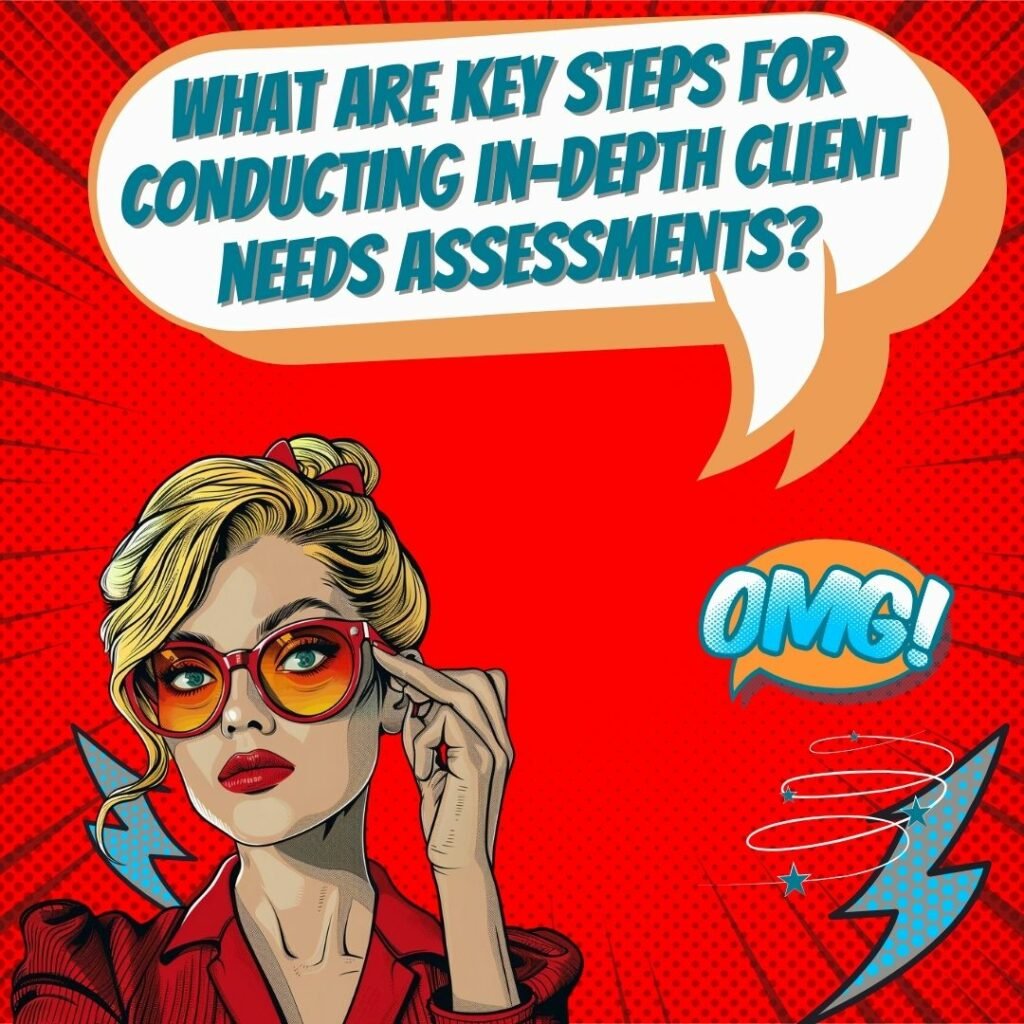Key Takeaways
✅ Conduct Thorough Needs Assessments: Dive deep into your customer's world. Explore what keeps them up at night, their goals, and the barriers they face. By asking open-ended questions and piecing together a complete picture, you gain trust and set the stage for tailor-made solutions. Statistics say, a startling 69% of customers are likely to switch brands if they feel unheard—thus, thoughtful needs assessments are undoubtedly the bedrock of keeping clients engaged and invested.
✅ Emphasize Active Listening and Empathy: Forget just waiting for your turn to speak. True active listening can boost your client retention rates by as much as 40%. Engage with your customers’ concerns and aspirations to show that you’re in their corner, not just in the deal for the paycheck.
✅ Focus on Providing Value and Solutions: Adopt a consultative stance, guiding customers through their pain points to solutions that slot neatly into their narrative. Shifting the sales conversation away from features to value can enhance deal closure rates by up to 70%. In consultative selling, you're not just selling a product; you're offering a bridge to your customer's success.

Introduction
Are you struggling to turn leads into loyal customers? It might be time to shift gears from high-pressure sales pitches to a method that's all about the customer – Consultative Selling. This customer-centered approach is revolutionizing the sales industry, paving the way for more meaningful interactions and successful outcomes. By focusing on thorough needs assessments and adopting solution selling, you can open up a world of better results.
In Understanding Consultative Selling: The Key to Success, we'll unveil the essentials behind this powerful strategy and why today’s top performers are embracing it. From conducting insightful Needs Assessments to illuminate hidden opportunities to leveraging Embracing Solution Selling, this article will navigate you through the sales landscape's evolving expectations.
Forward-thinking sales practices like thorough Effective Questioning Techniques and creating Compelling Value Propositions aren't just buzzwords – they're actionable methods that connect to your customer's deepest needs. Add to that solid advice on Putting it into Practice and overcoming real-world Common Obstacles, and you're on your way to not just sales success, but building lasting relationships based on trust and shared success.
Top Statistics
| Statistic | Insight |
|---|---|
| 87% of new sales training is lost within a month | This indicates a need for ongoing training and support in consultative selling to ensure that skills and knowledge are retained. |
| 85% of sales training fails to deliver a positive return on investment | Investing in quality training focused on consultative selling may represent a more cost-effective way to boost sales performance. |
| 78% of business buyers seek a trusted advisor who adds value to their business, not just a salesperson | Consultative selling, which emphasizes adding value and building trust, is clearly aligned with modern buyer’s expectations. |
| 57% of salespeople are expected to miss their quotas this year | This highlights the challenge facing sales teams and the potential for consultative selling approaches to improve quota attainment. |
| 81% of those surveyed said that trusting a brand to do what is right plays a big part in their decision to purchase | Trust is a key factor in sales success, suggesting the importance of ethical conduct and genuine concern for customer needs in selling strategies. |
What is Consultative Selling?
Have you ever walked into a store and felt like just another number? That's transactional selling – where the conversation is short, and the focus is on the sale, not the person. Consultative selling flips this on its head. It's about the long game - building relationships, understanding the individual needs of each customer, and offering solutions. In a world where customers are bombarded with options, the personal touch of consultative selling isn't just nice; it's necessary for standing out. This approach demands more than a smile and a sales pitch; it requires genuine care and interest in the customer’s needs. Successful consultative sellers make their customers feel valued and heard. This method leads to lasting relationships and repeat business. Ultimately, it's about prioritizing the customer's needs above all else.
The Importance of Needs Assessments
Imagine trying to solve a puzzle without all the pieces. Without a needs assessment, sales professionals are just guessing what their customers want. It’s like throwing darts blindfolded and hoping to hit the bullseye. A needs assessment is about asking the right questions and listening - really listening. The goal is to uncover not just the obvious, but the underlying or unexpressed needs that a customer may not even be aware of. This can lead to hidden opportunities – those that can transform a standard sales pitch into a customized solution that fits the customer like a glove. Thorough needs assessments can reveal problems customers didn't even know they had. This allows sales professionals to offer more effective, tailored solutions. By understanding the full scope of a customer's needs, sellers can provide exceptional value.
Solution Selling: A Focus on the Customer
Who doesn't like being the center of attention? Solution selling puts the customer in that sweet spot. It's not about selling a product or service; it's about selling an answer to a problem. The benefits are twofold: customers feel understood and are more likely to remain loyal, while businesses enjoy increased satisfaction and more robust revenue growth. By understanding the exact challenges a customer faces, sales professionals can tailor their offerings, creating a match that feels less like a sale and more like a personal favor. This approach fosters trust and loyalty. It positions the seller as a partner, not just a vendor. Solution selling helps build stronger, long-term customer relationships.
Effective Questioning Techniques
The art of asking questions is at the core of consultative selling. How can you identify what the customer needs if you don't ask? But it’s not about firing off a list of pre-set questions. Effective questioning is a dance. Using open-ended questions, probing deep, and getting clarification are all steps in this dance. It’s about guiding the conversation to reveal the customer's true challenges and desires, leading to a solution that feels as though it was designed just for them. Good questioning helps uncover hidden pain points. It also shows the customer that the seller is genuinely interested in their needs. Mastering this technique leads to more meaningful and productive sales conversations.
Transforming Needs into Solutions
Turning needs into solutions is like finding the right key for a lock. It’s not just about the features of a product or service; it’s about the value it offers to the customer. The core of a compelling value proposition lies in its relevance to the customer's unique needs, highlighting how their life or business will improve. It's more than just a good deal; it's about presenting a solution that customers can't resist because it feels tailor-made for them. Crafting a strong value proposition requires deep customer insight. It's about showing how the solution makes a real difference. This approach ensures that the customer sees the value clearly and compellingly.
Implementing Consultative Selling: Overcoming Challenges
The road to mastering consultative selling can be bumpy. Objections from customers, time management issues, and our own internal biases can all stand in the way. How does one navigate these challenges? By being prepared, staying empathetic, and adapting to each unique situation. Overcoming these common obstacles requires persistence, patience, and a willingness to continually learn from each interaction. Remember, each hurdle cleared is a step closer to becoming a pro at consultative selling. Persistence is key in overcoming sales challenges. Being adaptable helps in dealing with diverse customer needs. Continuous learning ensures ongoing improvement and success in consultative selling.
AI Marketing Engineers Recommendation
Recommendation 1: Leverage Data-Driven Customer Profiles: Achieve Consultative Selling Success by building detailed customer profiles using data analytics. In a recent survey, 80% of sales professionals agreed that having more insights into clients' business needs leads to more successful sales outcomes. By analyzing purchasing patterns, social media activity, and other customer data, sales teams can create a personalized needs assessment. This enables them to engage meaningfully with prospects, tailor messages, and predict future needs more accurately, which is critical for fostering trust and demonstrating value from the first interaction.
Recommendation 2: Implement Active Listening Training Programs: Embrace a culture where solution selling thrives by integrating active listening into your sales training. An essential part of consultative selling is understanding the underlying challenges that customers face, and statistics show active listening increases sales performance by as much as 40%. Investing in workshops or online courses for your sales force to better grasp the nuances of active listening can develop their ability to uncover real customer needs during conversations, leading to better solution-driven sales strategies.
Recommendation 3: Integrate CRM Solutions with AI Capabilities: Choose Customer Relationship Management (CRM) technology with built-in artificial intelligence to conduct thorough needs assessments more effectively. With 50% of teams improving their productivity by using AI with their CRM systems, the benefits are clear. AI can help in analyzing vast amounts of data to provide valuable insights into customer behavior and preferences, prioritizing leads based on their readiness to buy, and offering predictive analytics for more accurate sales forecasting. This not only streamulates the sales process but also allows the sales team to offer customized, solution-oriented services to their clients.
Relevant Links
- Harness AI for Unmatched Digital Marketing Success
- Master SEO with Our Expert Baidu Optimization Tips
- Leveraging Influencers for Marketing Impact
- Strategies for Success on Russia's Leading Online Retailer
- A Cultural Guide for Marketers in Japan
Conclusion
In an era where understanding and responding to customer needs is paramount, consultative selling has emerged as the key to unlocking the full potential of customer relationships. It’s clear that shifting from transaction-based interactions to a customer-centric approach requires not just a change in mindset, but also a mastery of certain skills and techniques. Have you considered how adept you are at conducting a thorough needs assessment, or how well you tailor solutions to your customer's specific pain points?
The power of a well-executed needs assessment cannot be overstated, as it not only uncovers hidden opportunities but also fosters a deeper bond between you and your customer. And remember, the insights gathered through effective questioning lay the groundwork for crafting those compelling value propositions that customers find difficult to resist.
But what about solution selling? Embracing this approach leads to customer satisfaction that encourages loyalty and contributes to a healthier bottom line. It essentially means your customers come back, not because they have to, but because they want to. The real question is, are you ready to embrace these changes and integrate them into your sales techniques? As you venture into the realm of consultative selling, bear in mind that overcoming the hurdles like handling objections and managing time is part of the journey. Stepping into your customer's world, understanding their challenges, and offering solutions that hit the mark is no small feat. Are you prepared to take on this challenge?
In conclusion, achieving success in consultative selling necessitates a genuine commitment to understanding your clients and proposing solutions that genuinely serve their interests. As businesses continue to navigate an ever-changing marketplace, those who master this art will not only see improved results but will set a benchmark in the standards of customer engagement. So, what’s your next step towards consultative selling success?
FAQs
Question 1: What is consultative selling?
Answer: Consultative selling is all about getting cozy with customer needs, building a solid trust, and whipping up solutions that fit like a glove. Sales reps get to be more like trusty sidekicks rather than just peddlers of stuff.
Question 2: How does consultative selling differ from solution selling?
Answer: Consultative selling is like taking a step back to look at the whole picture—what the customer's dreams and worries are—while solution selling zeros in on a specific hiccup and pitches the product as the knight in shining armor.
Question 3: What are the key principles of consultative selling?
Answer: Imagine you're a detective of sorts. You've got to ask all the right questions, listen like your secret superpower is hearing between the lines, get the lay of the customer's land, cook up some problem-solving strategies, and create a bond that's tighter than a jar of pickles.
Question 4: What skills are essential for effective consultative selling?
Answer: To be a whiz at this, you've got to have business smarts, knowledge, and experiences up your sleeve, ready to offer game-changing perspectives and help customers make smart choices. Stay hungry for knowledge and keep tabs on what's happening around you.
Question 5: How do you identify unique pain points and provide customized solutions?
Answer: Open your ears and ask questions that'll make your clients say, "Huh, never thought of it that way." When clients see their own puzzles in a new light, you can tailor solutions that get straight to the heart of the issue.
Question 6: How can you build strongue relationships with clients using a consultative sales approach?
Answer: Kick old habits and outdated methods to the curb, boost your team's skills with top-notch sales training, and bring your A-game with strategies that really click with your clients. That's how you nurture trust and make client relationships go the distance.
Question 7: What are some effective consultative selling questions to ask?
Answer: Try these on for size:
- What's got you searching for a solution now?
- Why did you decide to chat with me today?
- Where do you see your business in a couple of years, and how might that shake up your needs here?
Question 8: How should you ask consultative sales questions?
Answer: Keep it real—show that you're actually interested, tag on some follow-up questions, and sprinkle your conversation with queries to keep it flowing like a friendly talk rather than a grilling session.
Question 9: How can you track your consultative selling skills?
Answer: Get your hands on tools and strategies to monitor how you're doing and continuously polish those consultative selling superpowers.
Academic References
- Manning, G., & Reece, B. (1997). Consultative Selling: The Hanan Formula for High-Margin Sales at High Levels. This seminal work delves into the selling process with a focus on building relationships and understanding what customers really need. It's a guide for sales professionals to align their pitch with their client's needs, ensuring a higher chance of success.
- Arredondo, L. (1994). Perfect Phrases for Sales Presentations: Hundreds of Ready-to-Use Phrases for Delivering Powerful Presentations That Close Every Sale. Arredondo provides a structured blueprint for sales presentations that resonates with the reader by aligning product features with the prospective customer's needs, leading to effective closing statements.
- Brinkman, R., & Kirschner, R. (1994). Dealing with People You Can't Stand: How to Bring Out the Best in People at Their Worst. This book offers insights into the human aspects of sales, illustrating how to establish and maintain rapport with different customer personalities and how to transition smoothly from friendly banter to serious business discussions.
- Goldberg, M. J. (1996). Knock Your Socks Off Selling. Goldberg's work highlights active listening and effective questioning as key components of understanding a customer's needs, thus building a strong foundation for consultative selling and long-term customer relationships.












